Key Points:
- The Himalayan Tahr, an ungulate similar to a rocky mountain goat in appearance but with a thicker, longer coat of hair, lives at elevations up to 16,400 feet. The hooves of the Himalayan tahr are uniquely designed for walking on rocky mountainsides.
- Kiangs (a breed of large wild asses) live in groups of up to 400, inhabiting elevations as high as 17,700 feet above sea level. They have longer hair in the winter to keep warm and shorter hair in the summer. Their only predators are wolves.
- Because they have larger hearts and lungs than other members of the bovine family, as well as a higher blood cell count, yaks are better equipped to withstand freezing temperatures. They can live in altitudes up to 20,000 feet above sea level.
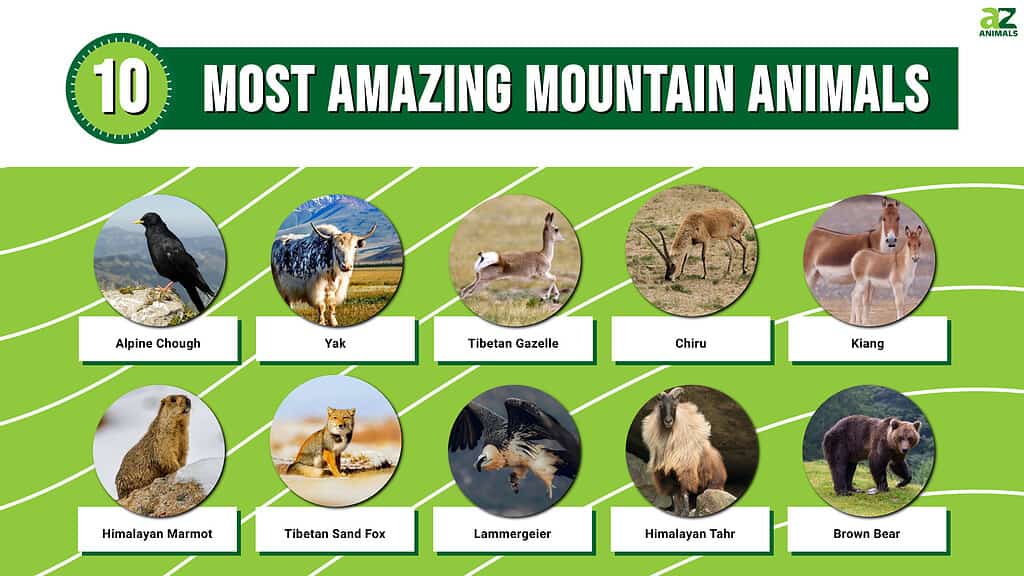
Animals living in the mountains must have special adaptations to survive. They often must be able to walk well in snow and on ice. Especially at the highest elevations, the air is thinner, making it harder to breathe. They also have to have a diet and habitat that they can find at the highest elevations on earth. These 10 mountaanimals have special adaptations allowing them to live in the mountains.
#10 Amazing Mountain Animal: Brown Bear
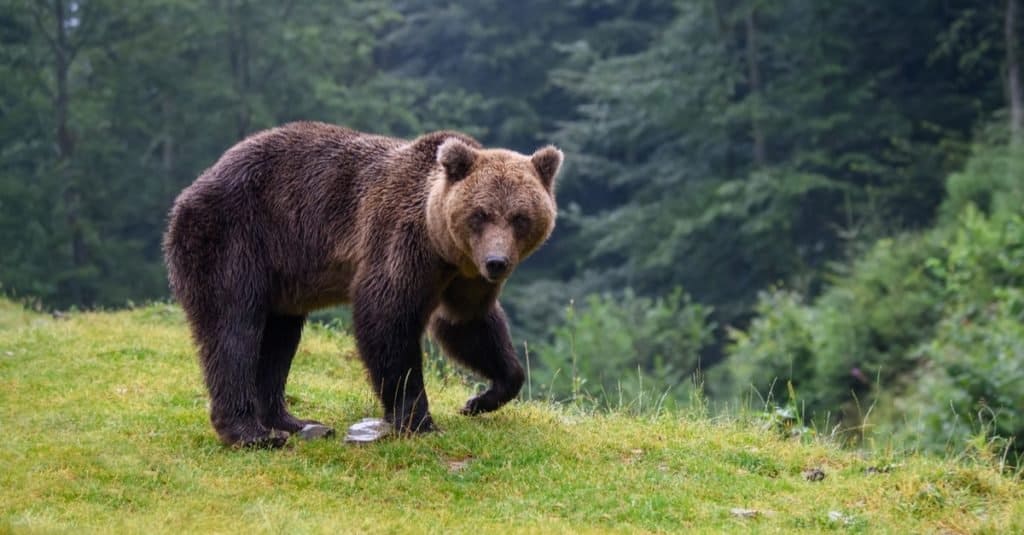
©Volodymyr Burdiak/Shutterstock.com
Brown bears live in many locations around the world up to 16,400 feet above sea level. The brown bear has long blunt claws that they can use to dig up food, even when buried in ice and snow. Brown bears are at the top of the food chain as they are powerful enough to break the necks of many animals with a single spat. Their thick layer of fat helps to keep them warm. They have a great sense of smell, so they can often smell food up to 1 mile away. Finally, brown bears will eat almost anything, including plants and animals, making food easier to find.
The way bears survive tough winter conditions at high elevations is through hibernation. Bears can actually lower their body temperatures 8-12 degrees, and their bodies break down stored fat for energy. This process helps them to survive without eating or drinking for as long as 7 months.
#9 Amazing Mountain Animal: Himalayan Tahr
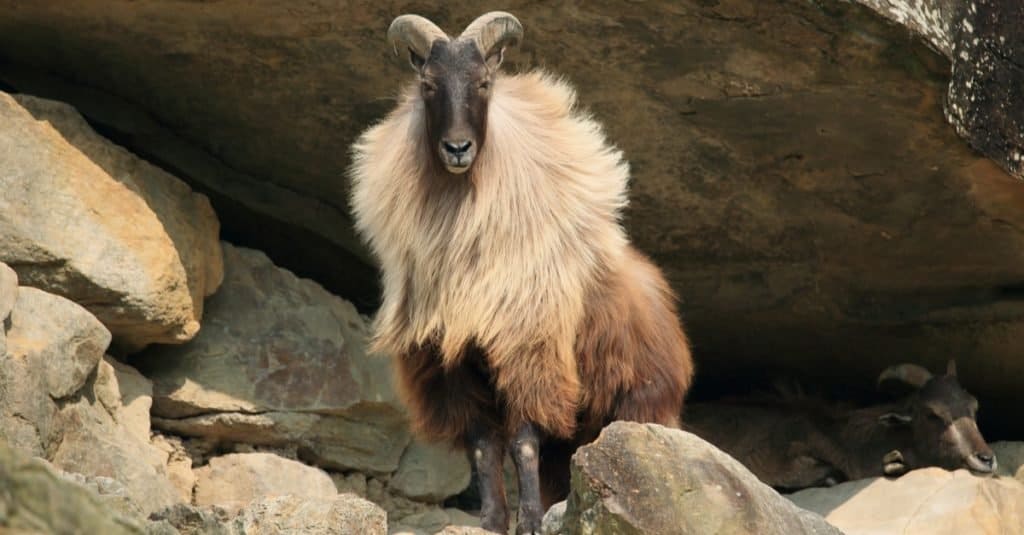
©Japan’s Fireworks/Shutterstock.com
The Himalayan tahr lives at elevations up to 16.400 feet above sea level. This animal has a thick two-part coat that grows long in the winter. The extra length and the thick undercoat help insulate it during cold weather.
One cool adaptation of the tahr is that the hooves of the Himalayan tahr are uniquely designed for walking on rocky mountainsides. The hooves have a hard outer core to help protect them while the middle is softer, allowing them to walk better on uneven ground. Since it is easy for them to move around, they navigate to higher ground to feed during the day. They often rear up on their back legs and use their front legs like arms to reach vegetation that other animals, like mountain goats, cannot get. Once evening arrives, they move to lower elevations, where it is usually warmer.
#8 Amazing Mountain Animal: Lammergeier
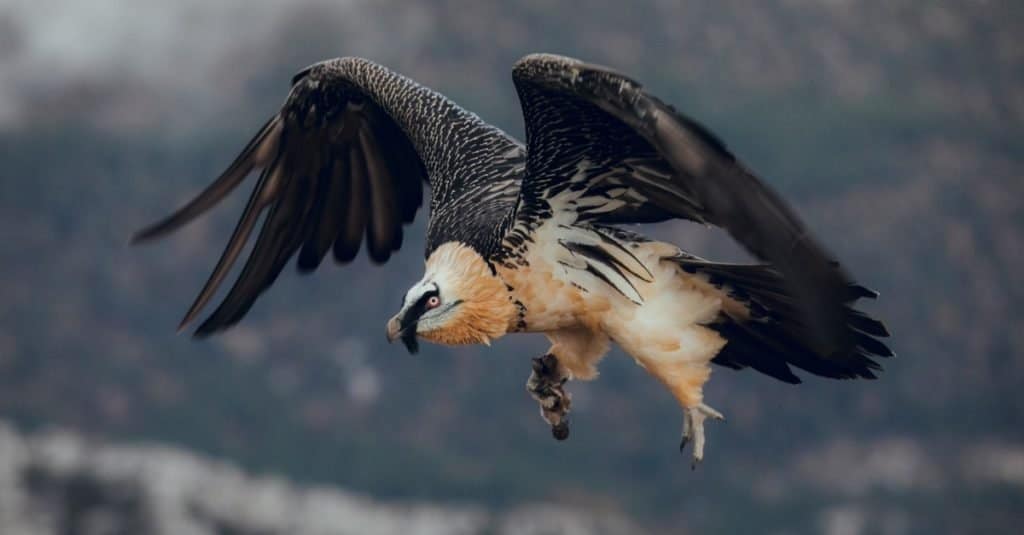
©Aitor Lamadrid Lopez/Shutterstock.com
The lammergeier (Gypaetus barbatus) also called the bone-eating vulture, lives at altitudes up to 16,400 feet above sea level. The sole member of the genus Gypaetus, its name means “lamb eater” in German, and this scavenger of many names is also known as the bearded vulture, the bearded vulture-eagle, the bone breaker, and the ossifrage.
In spite of being referred to as a vulture, and its closest relative being the Egyptian vulture, it isn’t one – experts assert the lammergeier is more closely related to hawks and eagles (just like its North African cousin).
This bird eats a diet composed of about 80% bones, so it can easily find food left by other animals. The lammergeier is known for its penchant for tossing heavier bones from great heights onto rocks to break them before consuming them.
Its stomach acid has a pH level of about 1, so it can digest most bones in under 24 hours. These birds have no natural predators.
#7 Amazing Mountain Animal: Tibetan Sand Fox
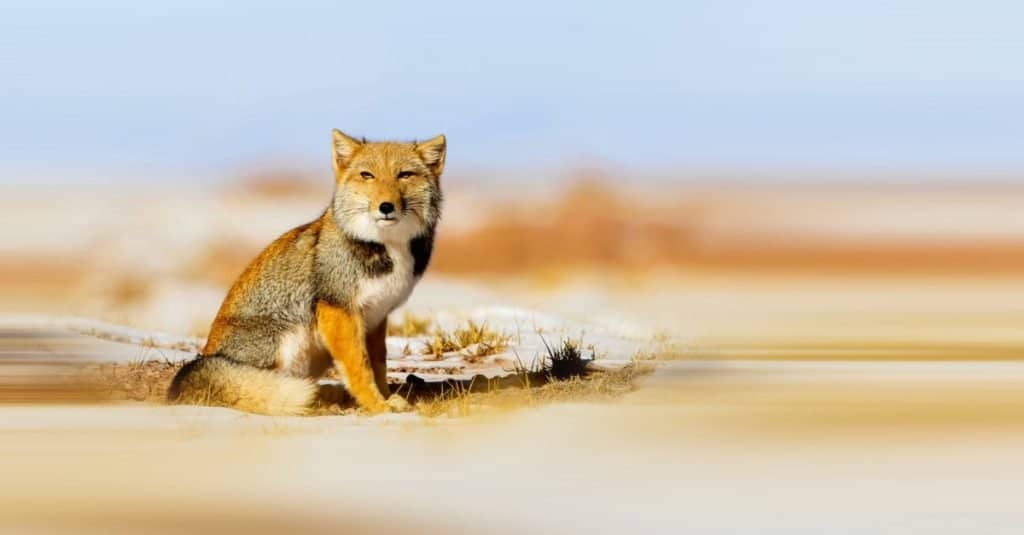
©Wang LiQiang/Shutterstock.com
The Tibetan sand fox lives in altitudes up to 17,100 feet above sea level. These animals have thick fur coats, so it is easy for them to handle the cold. They can be found in India, Nepal, Tibet, and Western China and live on the Ladakh and Tibetan Plateaus. There they hunt their favorite foods, hares, marmots, pikas, and lizards. Occasionally survival might mean teaming up with the mighty predator of the heights, the brown bear. Using its quick reflexes, a sand fox snatches the fleeing mammal unearthed by the lumbering bruin.
They have a powerful jaw, which makes them able to eat a variety of meat. Male and females usually bond for life, and they work together as a team when they hunt. They have a keen sense of hearing, making it easier for them to hear their favorite meal of rodents scampering as they try to get away.
#6 Amazing Mountain Animal: Himalayan Marmot
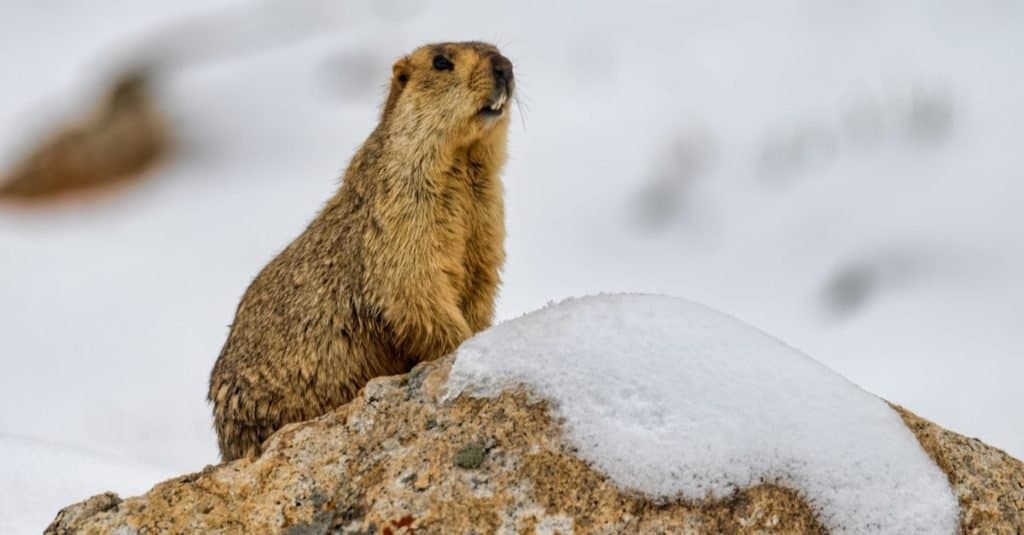
©Kamal Hari Menon/Shutterstock.com
The Himalayan marmot lives in elevations up to 17,100 feet above sea level. They live in dens up to 30 feet deep in the ground with their families up to 6 months out of the year. Each of their front feet has four toes with long concave claws, allowing them to burrow better. Since there is more than one animal in the burrow, it is easier to keep warm. This is especially helpful to the pups. While all Himalayan marmots stay in the burrow for about 6 months annually, females with young often spend another two months. While females are in the den, males are usually close by and constantly scan any signs of danger. When a Himalayan marmot hears or sees danger, they communicate through a low series of alarm calls, which they repeat every 5-to-20 seconds.
Researchers found that the Himalayan marmot has an adaptation of their Slc25a14 gene compared to marmots that live at lower altitudes and other rodents. They believe this adaptation makes it easier for the animal to breathe in the thinner air and helps to control their body temperatures. These marmots have rapid reflexes, which help them catch prey easier.
#5 Amazing Mountain Animal: Kiang
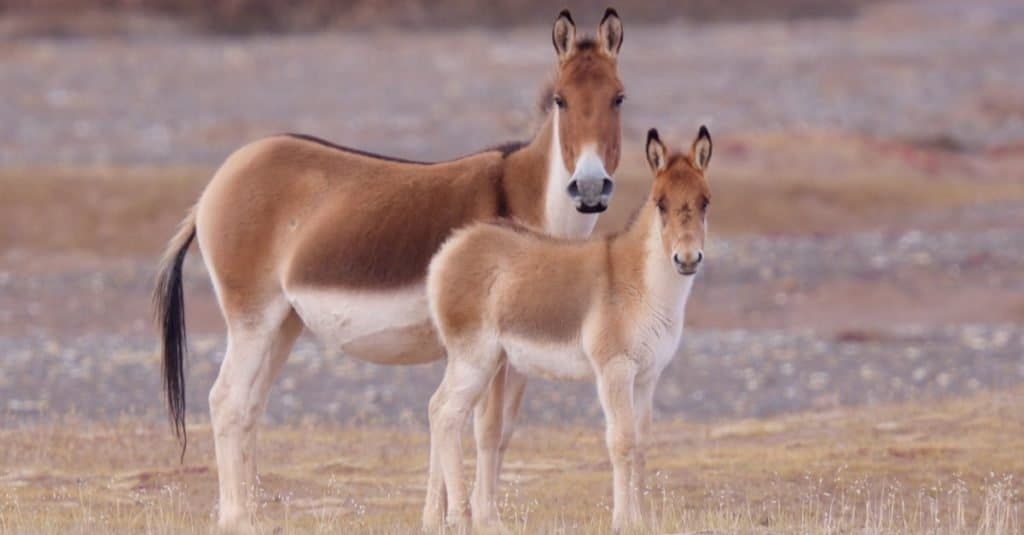
©Hugh Lansdown/Shutterstock.com
Kiangs live in elevations up to 17,700 feet above sea level. These animals that are the largest wild asses have longer hair in the winter to keep them warmer and shorter hair in the summer. These animals deliver their young when food is most plentiful. Their only predator is wolves.
Kiangs live in groups of up to 400 animals. These tightly cohesive groups can travel a long way for food because kiangs have very stout legs. When food is most plentiful in July and August, they put on up to 90 extra pounds, which they can use when the grass is harder to find in the winter.
#4 Amazing Mountain Animal: Chiru
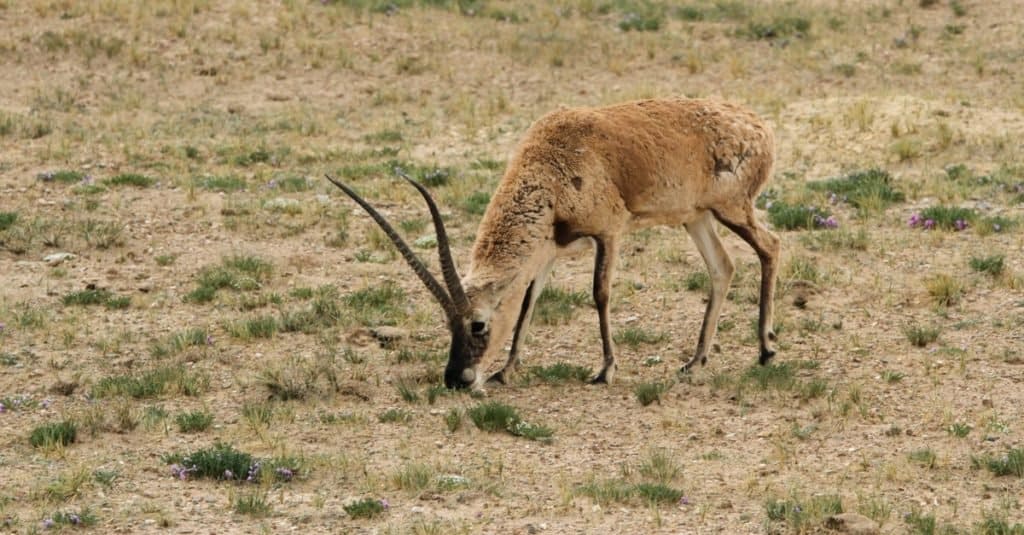
©Agami Photo Agency/Shutterstock.com
Chirus, also called Tibetan antelope, live in elevations up to 18,000 feet above sea level. These animals migrate to lower elevations during the winter while staying in higher elevations during the summer. Some animals, which scientists believe are the healthiest and youngest, migrate while others remain in the winter feeding grounds all year long. These animals have a wooly coat, which helps to keep them warmer.
Chirus dig depressions in the ground when they are resting. This behavior still baffles scientists slightly, but most believe that the depressions up to 45-inches in diameter and 12-inches deep help conceal them from oestrid flies.
#3 Amazing Mountain Animal: Tibetan Gazelle
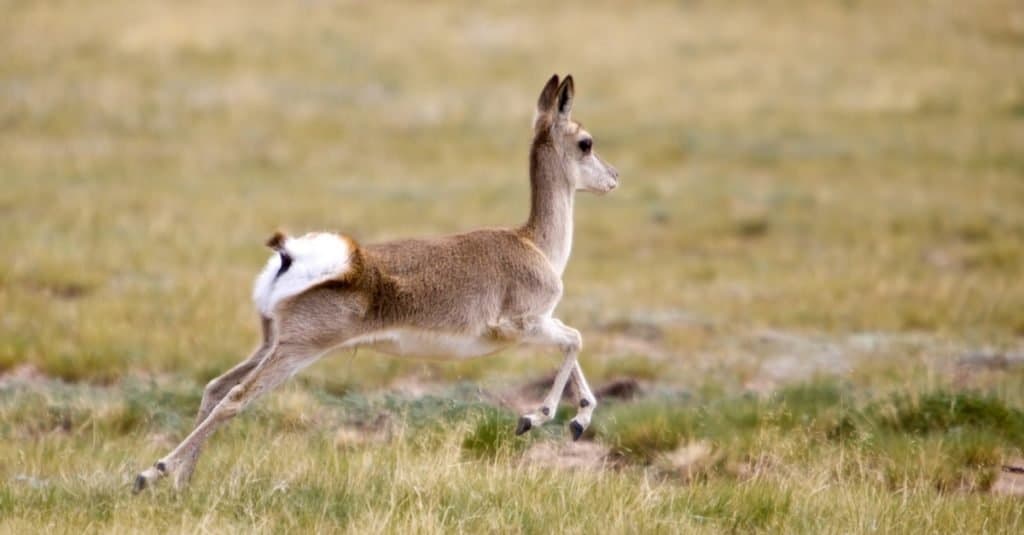
©Lian Deng/Shutterstock.com
Tibetan gazelles live in elevations up to 18,900 feet above sea level. These animals can run up to 43 miles per hour and keep at it for over 60 miles. In order to breathe in the thinner air, Tibetan gazelles do not develop adult hemoglobin, but they keep juvenile globin throughout their lives. This allows the animal to use what oxygen is available more efficiently. Scientists have not discovered any other species where this cool adaptation occurs. Additionally, these animals have special air sacs in their broad nostrils, which help them take in more oxygen.
The Tibetan gazelle has a double coat. Its outer coat is wooly to help keep them warm. Their coat gets longer in the winter and shorter in the summer. They also have a very dense undercoat.
#2 Amazing Mountain Animal: Yak

©SakSa/Shutterstock.com
Yaks can live up to 20,000 feet above sea level. The thick tongue of the yak helps it lick moss and lichen off rough surfaces. While there are not many nutrients in the diet that the yak consumes, they have a rumen. Chewing their cud, like a cow, helps them get more nutrients out of the available food. The rumen in the yak is extremely large. Therefore, they can take in more food at one time and let it sit until they are ready to eat it. The long intestine in a yak is also longer than in most animals. This also helps them get more nutrients from their food because it stays in their bodies longer.
Yaks also have larger hearts and lungs than other members of the bovine family. They also have a higher blood cell count. These are all cool adaptations as it helps keep the animal’s blood flowing at freezing temperatures, which allows its body to use oxygen more efficiently. Like many mountain animals, yaks also have a very dense coat. Its coat is water-resistant, which helps to keep the animal warmer. Additionally, it has broad hooves designed to walk across snowy and icy surfaces. Therefore, the yak has no trouble migrating to lower elevations during the winter.
#1 Amazing Mountain Animal: Alpine Chough

©Wolfgang Kruck/Shutterstock.com
The Alpine chough can live up to 21,300 feet above sea level. This bird has nested higher than any other bird in the world. They have broad, powerful wings and tails, which help them withstand strong winds. They also have deeply slotted wing tips making it easier for them to maneuver. These birds that fly in a flock often use air currents to cut down on the amount of energy they spend while flying. These birds nest in rocks, which helps protect them from strong winds.
The eggs have fewer pores than other eggs. Therefore, these eggs lose less water. The hemoglobin in the eggs is also different so it requires less oxygen. When the hatchlings are born, their body is covered with a thick downy covering.
Summary of the 10 Most Amazing Mountain Animals
Let’s review the animals that made the cut as the most amazing inhabitants of Earth’s mountain regions:
| Rank | Mountain Animal | Type of Animal |
|---|---|---|
| 1 | Alpine Chough | Bird |
| 2 | Yak | Bovine |
| 3 | Tibetan Gazelle | Antelope |
| 4 | Chiru | Antelope |
| 5 | Kiang | Wild Ass |
| 6 | Himalayan Marmot | Rodent |
| 7 | Tibetan Sand Fox | Fox |
| 8 | Lammergeier | Called a Vulture but related to the hawk and eagle |
| 9 | Himalayan Tahr | Wild Goat |
| 10 | Brown Bear | Bear |
The photo featured at the top of this post is © Daniel Prudek/Shutterstock.com
Thank you for reading! Have some feedback for us? Contact the AZ Animals editorial team.






